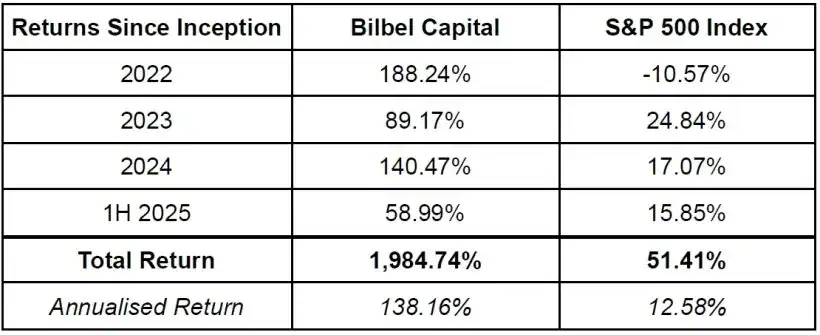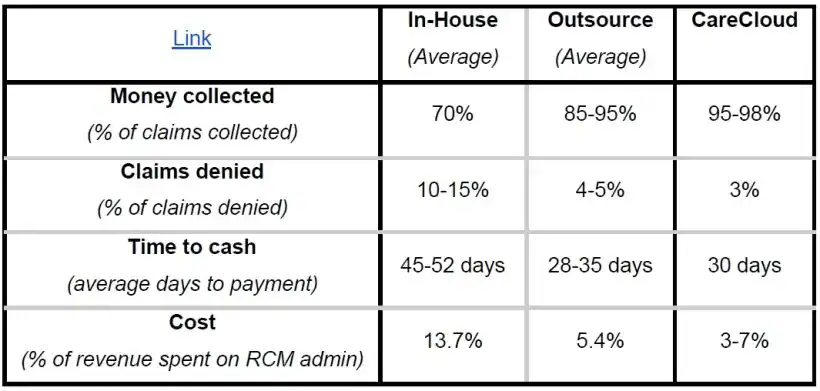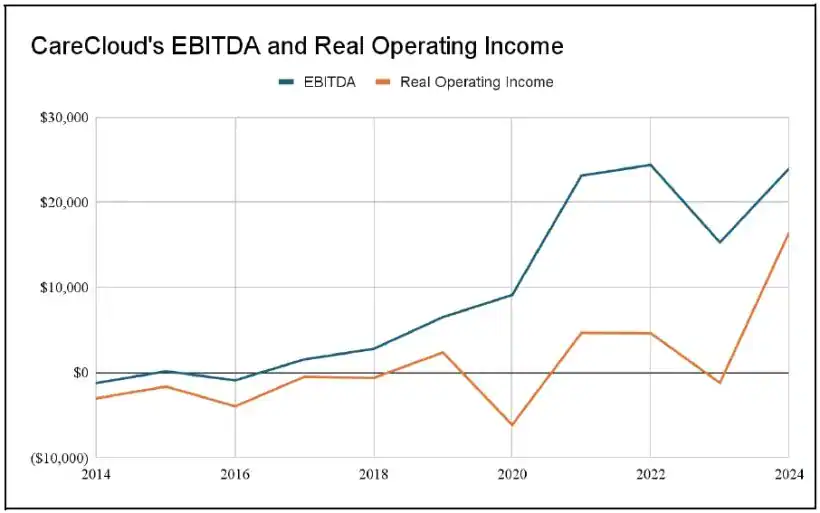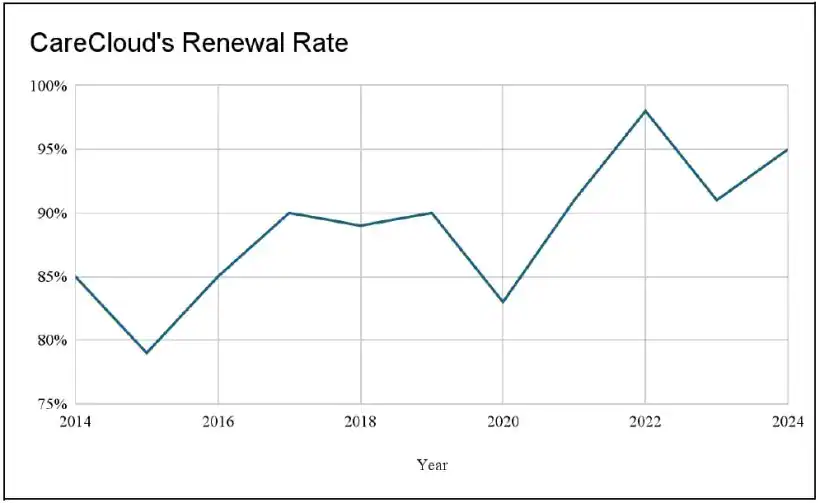Bilbel Capital's commentary for the second quarter ended June 30, 2025.
Dear Partners, thank you for your trust. We appreciate it very much.
We wrote this letter in simple English. If you don’t understand our letter, it’s our fault. Not yours.

Returns are time-weighted, and measured in EUR. Yearly periods run from February 1 to January 31. Half-yearly periods run from February 1 to July 31. Returns are unaudited.
Position Changes
We sold most of our shares in Reysas GYO to buy CareCloud. We think Reysas GYO is undervalued. But not as undervalued as CareCloud.
We also exited Dream International and Huationg Global (the previously undisclosed position).
We sold some Intellego. And invested in a few cheap, good companies.
New Portfolio Positions
CareCloud Inc.
CareCloud does Revenue Cycle Management (RCM). They make sure U.S. healthcare providers get paid for the care they deliver.
The process works like this:
- Before the visit. Check the patient’s insurance
- During the visit. Turn the doctor’s notes into billing codes
- After the visit. Send those codes as claims to insurers.
If insurers reject a claim, CareCloud corrects it and sends it again. Then, it bills the patient for what’s left. And collects the payment.
RCM runs on software like:
- Electronic Health Records (EHR) to store information, and
- Practice Management (PM) to handle admin tasks.
Together, these make Technology-Enabled Business Solutions (TEBS).
TEBS brings in 70% of CareCloud’s revenue, and almost all of its cash flow. That’s what we’ll focus on.
Why The Outsourced RCM Market is Growing
Outsourced RCM market = RCM market * Outsourcing share
1) RCM market
The RCM market grows for 2 reasons:
- There’s more money to collect, or
- It’s harder to collect the same money
When patients increase and prices go up, there’s more money to collect.
But insurers and growing billing codes make it harder to collect the same money.
- Insurers
A few big insurers control most of the U.S. market and set the rules. They often delay or deny claims. And each denial saves them money.
Even if they later approve a claim, the delay slows payment, and raises the providers’ costs. Unless these incentives change, insurers will continue.
- Growing Billing codes
Codes are short labels that stand for a test, treatment, or diagnosis. They help systems agree on what care was given.
New codes are easy to add. Insurers add codes to control payments and set stricter rules. Drug and device makers add codes so health providers can bill for their products. Public health agencies add codes to track diseases and safety.
But old codes are hard to remove. Health providers use old codes for audits and appeals. They need to prove the care they gave, and the payment they requested. Deleting them can cause claim errors, and make reports unreliable.

Bills use more than one code at a time. As the list grows, the number of code combinations grows much faster.
All this creates more work for doctors and staff. They must write detailed notes. And adjust for each insurer’s rules.
This admin work isn’t fun. U.S. health providers struggle to hire and keep billers. Wages keep rising and many employees leave.
Meanwhile, insurers keep raising deductibles and fees. So patients are paying a bigger share of their bills.
Collecting from patients takes longer than from insurers. So health providers must provide more payment plans. And follow up more often.
Collecting each dollar keeps getting harder and slower.
2) Outsourcing Share
RCM outsourcing share grows for 1 reason:
- It’s better than doing it in-house.
Universally, a better result depends on 4 things:
- How good the result is - (Money collected)
- How likely it will work - (Claims denied)
- How long it will take - (Time to cash)
- How hard it is to get - (Cost)
Outsourcing improves all 4 points. And costs less than doing it in-house. Switching to CareCloud improves results even more.

(Link)
Read more hedge fund letters here
The outsourced RCM market has grown 12% a year for the past 10 years. But 23% of healthcare businesses still don’t use it. Even though 90% say they want to.
Market Opportunity
RCM revenue is stable. Clinics almost never switch providers. They’d need to install new systems, retrain staff, and move all billing data.
Since RCMs control the flow of money, a switch can interrupt payments. Most providers already run on thin margins, so they avoid the risk. Even if the service isn’t great.
Today, 1,500-2,000 small RCMs are struggling. They don’t win new clients because their tech is outdated. They lack offshore teams, so they outsource and pay more. All this lowers profits and raises costs. Leaving many unprofitable.
This opens an opportunity to buy them. But who is it for?
Large RCMs avoid buying struggling RCMs. Onboarding takes similar effort for small and large clinics. But small ones bring in much less revenue. So the return isn’t worth it.
Large RCMs also innovate slowly. Their customers rarely leave, so there’s little pressure to improve their service. Today, their real advantage is not technology. But their locked-in customer base. So while their model keeps revenue steady, it limits their ability to buy and fix weak RCMs.
That leaves room for mid-sized buyers. A few can buy weak RCMs, cut costs, and upsell services. CareCloud works best because it combines the lowest costs with strong teams and software.
The market for buying them is large and growing. There are far more sellers than buyers. And consolidation will take many years.
Even if rivals matched CareCloud’s cost advantage, CareCloud would still do well.
CareCloud’s Business Model
Most U.S. RCMs grow through sales and marketing. They spend about 1.5% of revenue to get 1% more revenue each year. If the company runs at 20% profit margins, that’s a 13% return on investment.
It works. But it requires big, expensive U.S. sales teams. Because selling to large hospitals takes a long time.
CareCloud grows differently. It buys and fixes struggling RCMs. The business model is strong because they keep:
- Low fixed costs. $6M in working cash, and $5M in equipment
- Low operational costs. Their Pakistan team costs 85% lower than U.S teams
- Fast cash flow. They control the health provider's cash flow. As soon as they receive the revenue, they take a cut
This lets them:
- Buy struggling RCMs at 1-2x revenue
- Cut costs by 40-60% in 3-6 months
- Earn 30-40% returns on investment. Even after losing some clients
Deals with tiny businesses (<$5M revenue) are even better. The smallest ones are the weakest. So they can’t demand much in a sale. This lets CareCloud buy them with little or no cash upfront.
“And that particular transaction, you may recall, involved no money down. 100% of the purchase price is based on the revenue generated over time.” - CareCloud’s Q2 2025 earnings call, talking about RevNu Medical
CareCloud’s Previous Constraints
A company doesn’t grow to the level of its potential.
It grows to the level of its constraints.
CareCloud buys RCM companies. It keeps their clients, cuts costs, upsells services, and makes money.
To do this well, CareCloud needed 3 things:
- Cash to buy companies
- Strong, complete technology
- A skilled, low-cost team
For years, CareCloud had none. They had no money; weak technology; and a small, unskilled team.
The service wasn’t great. But over time, they improved each part.
1. Cash to buy companies
From 2013 to 2021, MTBC (now CareCloud) bought over 20 healthcare IT companies. Taking revenue from $10M to $140M.
But they didn’t have cash to buy them. So they used preferred shares (loans that can turn into stock).
Those preferreds paid a 9% annual dividend. This soaked up most of the company’s cash flow. And didn’t leave much for growth.
The strategy still worked because the business grew faster than the 9% cost. But later, when the preferreds converted into common stock, the dividend payments stopped.
That freed up $8M in cash each year. Which now gives CareCloud money to buy RCM companies.
2. Strong, complete technology
A complete system needed 3 things:
- Electronic Health Records (EHR) + Practice Management (PM): Record patient data and run the practice
- Interoperability: Move data cleanly between systems
- Automation + analytics: Cut errors and speed up billing To get them, CareCloud bought 3 companies:
- CareCloud Corporation (2020): Added cloud EHR/PM and interoperability.
- Meridian Medical Management (2020): Added automation (RPA microbots) and analytics.
- medSR (2021): Added help in hospital integration and interoperability.
Now, the platform is both strong and complete.
3. A skilled, low cost team
In 2004, MTBC (now CareCloud) started a small billing team in Pakistan. Over the past 20 years, it grew the team in both size and skill.
Today, CareCloud has 3,700 employees. Including 700 in software, and 500 in AI.
This allows them to deliver better services, faster than competitors. All while running at 85% lower cost.

Every constraint CareCloud solved, made its model stronger. And made it harder for others to compete.
Valuation Today
On average, similar companies trade at 18x EV / EBITDA:
| Company | EV | Sales | EBITDA | EV/Sales | EV/EBITDA | Status |
|---|---|---|---|---|---|---|
| Waystar | 7,140 | 1011 | 363 | 7.1 | 19.7 | Public company |
| HealthEdge | 2,600 | 400 | 86 | 6.5 | 30.2 | Sold for $2.6B |
| TransUnion Healthcare | 1,735 | 190 | 85.5 | 9.1 | 20.3 | Sold to for $1.7B |
| GeBBS Healthcare | 850 | 200 | 50 | 4.3 | 17 | Sold for $850M |
| Acclara (Providence RCM) | 724 | 300 | 25 | 2.4 | 29 | Sold for $724M |
| Trubridge | 462 | 343 | 53.1 | 1.3 | 8.7 | Public company |
| i3 Vertical RCM | 96 | 45.5 | 9 | 2.1 | 10.7 | Sold for $96M |
| Viewgol | 36 | 19 | 4.5 | 1.9 | 8 | Sold for $36M |
| Average (Median) | 787 | 250 | 52 | 3.3 | 18.3 | - |
| CareCloud TEBS | 155 | 74 | 27 | 2.1 | 5.7 | Public company |
Numbers in millions of USD.
CareCloud (TEBS):
| Market Cap | $100,726,453 |
| Cash Today | $10,500,000 |
| Series A | $26,779,000 |
| Series B | $37,784,000 |
| Debt | $86,000 |
| Enterprise Value | $154,875,453 |
| EV / TEBS Revenue | 2.1 |
| EV / TEBS EBITDA | 5.7 |
CareCloud’s Share Price: $2.38 at 31st July close.
CareCloud trades at 5.7x EV / EBITDA. And its business is better than peers that trade at 3x the price.
Valuation In 1-2 Years
By the end of 2025, CareCloud will have $20M in cash. That alone could buy $15M in revenue. With debt and seller financing, they could do a $20-25M deal. Adding $6M-10M in EBITDA.
This would lift total 2026 EBITDA to $33M-37M.
If they repeat the play the year after, EBITDA could reach $39-47M. That translates to $20-27M in free cash flow. Vs today’s $100M market cap.
The stock is cheap now. And even cheaper looking forward.
Why Is CareCloud Cheap?
Share count is up. Revenue is down. And TEBS numbers are hidden.
This makes it easy to think the management is doing a poor job, and the business is in decline.
1. Share count is up
On March 6, 2025, CareCloud turned 3.5M Series A Preferred shares into common shares. This pushed the number of common shares from 16M to 42M. Overnight, preferred shareholders owned more than 60% of the common stock.
Before the news, the stock traded above $3.00.
After the news, it dropped to $1.6.
Why?
Preferred shareholders want 2 things:
- Less risk
- Steady dividends
When their preferred shares became common shares, they lost both. Now they faced all the company’s risks. And no dividend.
CareCloud had talked about converting their preferred shares since 2021. But the move still surprised investors. Causing many to sell, at the same time.
2. Revenue is down
From 2021-2024, most of the revenue drop came from 2 things:
- Two large hospitals left after the Meridian deal. CareCloud knew this, so they paid less for the company. The hospital exits made revenue look higher in 2021-2022, and lower in 2023. But both were misleading.
- Revenue from tech consulting for large hospitals fell. But this isn’t a core part of the TEBS business.
After we adjust for them, this is what we see:

CareCloud grows by buying RCMs. But they didn’t buy any from 2021-2024. So revenue decline matched their -4.5% customer loss rate.
Some clients closed. Others left due to weak service, but this came from previous constraints (refer to CareCloud’s Constraints, pgs. 5-7).
Today they’re solved.

3. TEBS numbers are hidden
RCM, EHR, and PM make up TEBS. But CareCloud doesn’t report TEBS on its own.
Instead, it bundles TEBS together with low margin services:
- MedSR (IT consulting business for hospitals)
- Medical Practice Management
- Printing & Mailing Services
- Vaccine Purchasing Services
That’s not all. The numbers also look smaller because CareCloud spreads the cost of past acquisitions over time.
To see TEBS profits clearly, we cut out the other businesses and add back those costs. After doing so, we see TEBS has $74M revenue and about $27M in EBITDA.
Summary
CareCloud was held back for years by lack of cash, weak technology, and a small team.
Now, all 3 constraints are gone.
TEBS is a strong business. It uses little money to make a lot. It can keep buying and fixing struggling RCMs for a long time.
At 5.7x EBITDA, we’re not paying much for the future.
If our explanation is better than the market’s, we’ll make money.
A very special thank you to Nick Peters (@nicholasp66 on X.com) for taking the time to share and explain the idea with us. We highly suggest you read through his exceptional insights on CareCloud.
Portfolio Positions
Intellego Technologies
Intellego made great progress this year.
Last year the stock was held back. Customers paid late, cash flow was weak, and they didn’t have audited financials.
Most of that is now fixed.
A big use of Intellego’s dosimeters is in UV curing. This is when UV light hardens liquids like glue, coatings, and plastics. Intellego’s dosimeters check if these surfaces get the right amount of UV light.
The curing market is big. It makes up less than 30% of Intellego’s sales today. But it will likely fuel most of Intellego’s growth.
The big money isn't made at the point of strongest evidence.
But at the point of clearest explanation, despite the lack of evidence.
Huationg Global (Previous Undisclosed Position)
Huationg Global is a civil engineering business in Singapore. It works on projects for government agencies. Like the HDB and LTA.
(HDB - Housing & Development Board, LTA - Land Transport Authority)
Singapore is well run, wealthy, and plans its infrastructure years ahead. Once approved, projects are rarely cancelled. And payments are always on time. This makes Huationg’s revenue steady and low-risk.
In August 2024, Changi Airport ended Huationg’s dormitory contract. Cutting $25M in revenue.
As a result, Huationg’s shares traded down to a market cap of $17M.
But its core civil engineering business was still making $8M to $10M a year. And the company had:
- $40M net cash
- $400M order book for the next 4 years
- Growth ahead from Singapore’s long term public projects
(Numbers in USD)
We bought at a $19M market cap. A few months later, the stock more than doubled. We sold our shares and bought into cheaper companies.
Undisclosed Positions
In recent months, we bought shares in companies trading at less than 2.5 times earnings. These businesses are improving over time.
We’re not revealing them yet. The shares are hard to find. And we want to buy more first. But we may share them later.
Returns Going Forward
We’ve done well since we started. But this partly came from finding rare opportunities. And partly from working with smaller sums of money.
As the fund grows, we’ll have fewer companies we can invest in. And lower returns than what we had in the past.
Still, we think we can outperform the S&P 500 in the long run.
How Long Do We Hold Our Stocks?
Holding period doesn’t depend on time. It depends on:
- Whether we have better opportunities
- Our cost of switching to them
Switching costs are:
- How fast we can sell and buy again
- Taxes and fees
Good vs Bad Ideas
What really matters, is not the ratio of good ideas to bad ones.
But how deep the best ones are.
Bad ideas only cause lasting harm if they stop us from finding good ideas.
Other than that,
All harm is finite, and
The best ideas are infinite.
Thank You
We’d like to leave a special thank you to a few individuals. You helped us when you didn’t need to, never asked for anything back, and spent your limited time with us when you could have spent it on yourselves.
Thank you.
And as always…
Yours sincerely,
Gabriel Sammut
We’re opening a U.S. LP for accredited investors with limited capacity. Apply here to see if you’re a fit.


